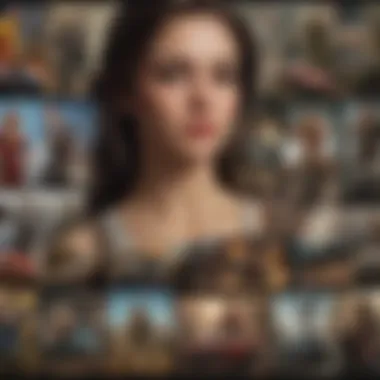Comprehensive Insights into Modern Entertainment: Games, Movies, TV Shows & Comics


Intro
Modern entertainment is a vast and ever-evolving arena. It encompasses diverse forms such as games, movies, TV shows, and comics. Each form has grown and adapted over the years to reflect cultural shifts and developments in technology. The synergy among these media not only entertains but also shapes society's values, beliefs, and discussions. Given such dynamics, it is essential to explore these forms precisely. This article digs deep into that exploration.
Overview of Games
Games today offer much more than mere pastimes; they serve as immersive experiences. Titles like The Last of Us Part II or Elden Ring showcase artful storytelling and elaborate worlds. These games captivate players, stimulating both thought and emotional response.
Overview of Movies
The film industry has undergone tremendous change. With franchises like Marvel Cinematic Universe and recent storytelling techniques, it needed to adapt to audience expectations. This evolution also reflects the technological advancements in CGI and practical effects.
Overview of TV Shows
Television has reshaped narratives with series like Breaking Bad or Game of Thrones showing intricate plots and character development. Streaming platforms like Netflix further disrupt traditional viewing habits, offering on-demand content.
Overview of Comics
Comics have transformed from simple illustrated stories to serious art forms. Titles such as Sandman and Saga present multi-layered narratives, challenging the stereotype of comics being juvenile. The market has expanded, engaging diverse audiences.
The interconnectedness of these entertainment forms creates a rich dialogue, engaging audiences in complex ways.
Notable Trends in Each Medium
Games
- Increased focus on inclusivity.
- Rise of live-service formats in franchises.
- Trends toward player-driven storytelling.
Movies
- Surge in streaming service productions.
- Emergence of international cinema.
- Serialized storytelling with movies linked to broader universes.
TV Shows
- Shorter seasons with high production values.
- Stand-alone episodes decorate intricate plots.
- Character-driven storytelling as a pillar of modern drama.
Comics
- Diverse creator voices enhancing representation.
- Canonical reboots and a rethinking around superhero narratives.
- Varied genres attracting wider readers beyond fantasy.
In analyzing these categories, we will contribute better to cultural discourse surrounding modern entertainment.
Concluding Thoughts
By evaluating current trends, audience engagement, and narrative depth, this exploration into games, movies, TV shows, and comics becomes vital in understanding modern culture. As we dissect these artistic forms, it helps delineate their impact on intersecting cultural and societal threads.
Understanding Pop Culture
Pop culture serves as a reflection of contemporary societal values, ideas, and trends. It encompasses a broad range of phenomena, including music, film, television, fashion, and gaming. Discussing pop culture is crucial in this article because it not only shapes everyday experiences but also influences behavior, perceptions, and the collective consciousness of society.
Definition and Importance
Pop culture is often defined as the set of ideas, practices, and phenomena that are prevalent among the general populace at any given time. This might include trending music, hit TV shows, popular films, or renowned video games. Its importance lies in how it shapes individual and community identities, engenders dialogue, and pushes societal norms.
Understanding pop culture enables insights into consumers' preferences: where they invest their time and energy. For example, millennials engage deeply with streaming services and social media platforms, which shapes their viewing habits and consequently influences television and film production. This recognition helps creators develop relevant content that resonates with audiences on multiple levels.
Origins of Modern Pop Culture


Modern pop culture has its roots in various historical periods and transformations. It can be traced back to the early 20th century with the rise of mass media. The establishment of radio and television became milestones that facilitated shared experiences across diverse communities.
The post-war era saw the blossoming of youth cultures and the counterculture movements, which further defined trends within society. Talents like Elvis Presley and The Beatles left significant marks on music and youth identity.
The technological advancements of the late 20th and early 21st centuries have acceleratingly influenced modern pop culture. The advent of the internet has enabled instantaneous communication and representation of diverse cultures worldwide. This exists side by side with phenomena like reality television and viral challenges which become flashpoints for engagement.
In essence, pop culture evolves as society evolves - progress driven by technological shifts and shared human experiences.
The Evolving Landscape of Video Games
Video games have become a significant part of modern entertainment and culture. Their impact extends beyond leisure, influencing everything from social interactions to education. Understanding this evolving landscape helps grasp the trends that shape gaming and the subtle changes within our society.
Current Trends in Gaming
Modern gaming emphasizes immersive experiences. Developers strive to create worlds where players feel a deep connection. Several trends are prominent now:
- Virtual Reality (VR): This technology transforms how players interact with games. It offers unique perspectives that traditional consoles cannot match.
- Augmented Reality (AR): Games like Pokémon GO show how AR can blend digital elements with reality. Such innovations keep players engaged and encourage outdoor activity.
- Mobile Gaming: The rise of smartphones means more people game on the go. This inclusivity expands the market and breaks the traditional boundaries of gaming.
- Cross-Platform Play: Gamers prefer flexibility to play across different systems. Allowing gameplay between consoles, PCs, and mobile devices fosters a more united gaming community.
These trends reveal how gaming is not just passing time but fostering connections and experiences.
Impact of Technology on Gaming
Advancements in technology significantly shaped gaming. As new tools emerge, they redefine possibilities. Consider the following:
- Graphics and Processing Power: Enhanced consoles such as the PlayStation 5 and Xbox Series X offer stunning visuals. Realistic graphics elevate the player's experience.
- Online Connectivity: Fast internet allows for seamless multiplayer experiences. Gamers can connect globally, increasing competition and collaboration.
- Artificial Intelligence (AI): Modern AI creates non-player characters that mimic human responses. This innovation enriches storytelling and enhances gameplay.
- Cloud Gaming: Services like Google Stadia promote gaming without needing high-end hardware. It shifts the focus from owning consoles to accessing experiences.
Thus, technology nurtures an environment where creativity can flourish and keeps expanding the boundaries of what is possible.
The Rise of Indie Games
Indie games are a noteworthy part of the modern gaming landscape. They increasingly capture attention for multiple reasons:
- Creative Freedom: Independent developers often take risks. They deliver unique stories and styles that larger studios might avoid due to commercial pressures.
- Community Support: With platforms like Kickstarter, indie games find funding and audiences. Gamers enjoy playing titles that have community backing and genuine passion.
- Diversity in Gaming: Indie titles often feature diverse narratives. This variety reflects different cultures and experiences, appealing to a broader audience.
- Affordability: Many indie games are priced lower than big studio releases. This affordability enables wider access to innovative gameplay experiences.
The growth and success of these games show a shift. Players seek fresh perspectives and embrace the artistic exploration that indie titles supply.
The Cinematic Experience
The cinematic experience forms a cornerstone of modern entertainment. Film not only provides an escape to different worlds, but it also serves as a lens to examine societal norms, human conditions, and cultural nuances. Understanding how cinematic narratives are shaped enhances appreciation for both artists and audiences. Furthermore, filmmakers effectively use cinema to influence thoughts and drive cultural conversations.
Analyzing Recent Film Trends
Recent years have shown a shift in film narratives and production methodologies. Traditional blockbusters dominate box offices, but they grapple with challenges from independent films that often explore unconventional stories fueled by authenticity.
- Rising popularity of diverse casting and storytelling styles
- Increased incorporation of special effects and technology
- Shift from large theaters to home viewing experiences
These changes reflect shifting audience preferences. Viewers want more than entertainment; they seek stories and characters that resonate on a personal level. The integration of genres and hybrid storytelling approaches showcases creativity, compelling audiences.
The Role of Streaming Services
Streaming services have redefined access to cinema. Netflix, Amazon Prime Video, Disney+, and others have altered the way films are produced, distributed, and consumed. Their impact can be analyzed through several key factors:
- Diverse Content Library: Curated offerings appeal to wider demographics, making global content easily accessible.
- Binge-Watching Culture: Viewers appreciate flexibility in consuming films and series at their own pace.
- Original Programming: Production of unique films increases competition. High quality content draws viewers in, setting a new industry standard.
Television in the Modern Era
Television has undergone a significant transformation in the modern era. With the rise of streaming platforms and the decline of traditional cable subscriptions, the way audiences consume content has drastically changed. This section highlights the various dynamics that shape television today, emphasizing its impact on entertainment culture.


Trends Reshaping TV Shows
Several key trends are at the forefront of changing television shows. Firstly, narrative complexity has grown. With shows like Succession and The Queen's Gambit, there is a stronger focus on character development and intricate plots. Viewers expect depth and sustainability in storytelling.
Secondly, shortened seasons are now common. Many series release six or eight-episode seasons rather than the traditional twenty-plus. This allows for tighter narratives and less filler content.
Lastly, the use of audience feedback and data analytics shapes programming decisions. Show runners frequently assess viewer interactions to tailor content specifically to their tastes and preferences.
The Influence of Binge-Watching
Binge-watching alters how stories are told. Many people watch entire seasons in one sitting because services like Netflix allow for effortless access. This behavior encourages plot arcs crafted for longer viewing spans. Writers and directors create cliffhangers and interconnected storylines specifically to capture viewer attention for extended periods.
Furthermore, binge-watching influences social interactions. Viewers discuss shows in depth, fostering communities that share insights and theories. Platforms like Reddit and Facebook allow fans to connect and form opinions.
“Binge-watching has become as integral to modern TV culture as the content itself.”
Diverse Narratives on Screen
The modern television landscape also embraces diverse narratives. Programs now portray various cultures, lifestyles, and experiences. Initiatives aimed at representation have gained momentum within the industry, leading to shows such as Pose and Master of None. These series allow audiences to see stories from perspectives that may differ from the mainstream. Diverse storytelling adds authenticity and depth, enhancing the viewer’s connection to the characters.
Moreover, the portrayal of gender and sexual identity continues to evolve. Complex characters challenge established tropes, demanding a reevaluation of how stories about identity are constructed and received.
Television today not only entertains but also reflects societal progress and raises awareness about important themes. The richness and diversity in narratives help to clarify issues, leading to dialogue around critical subjects like race, gender inequality, and mental health. Through varied stories, television cultivates empathy and understanding across communities.
Comics: A Timeless Medium
Comics have a distinctive place in the entertainment landscape. They blend visual art with storytelling, creating a unique medium that appeals to a wide audience. The importance of comics within modern culture cannot be overstated. They often serve as a platform for creativity, provide commentary on societal issues, and resonate with readers of all ages. In an era when audience engagement is paramount, comics have remained a steadfast presence, reflecting and influencing cultural narratives.
The Evolution of Comic Art
Comic art has undergone significant transformation since its inception. Originally, comics followed a strict format, sticking to standardized character designs and simplistic story arcs. However, with time, artists began to experiment with styles, moving from the traditional black and white to vibrant colors and diverse artistic techniques. This evolution allowed for poignant storytelling that could encompass a variety of themes. As digital tools have advanced, even more innovative methods of illustrating comics have emerged, enabling creators to manipulate visuals and tap into a wider array of storytelling avenues. The work of artists like Jim Lee and Alex Ross exemplifies how comic art has increasingly embraced complexity and depth.
Comics and Social Commentary
Beyond entertainment, comics serve a critical function as a vessel for social commentary. They have the capacity to spark dialogue around pressing issues such as race, gender, and politics. For instance, works like Watchmen and Maus highlight the balance between fiction and truth, often provoking thought in readers about the real-world implications of the narratives. Comic narratives can illuminate injustices, offering unique perspectives that traditional media may overlook. This dual role as entertainment and social commentary enriches the medium’s cultural significance and makes it a powerful tool for exploration and understanding.
The Rise of Graphic Novels
The advent of graphic novels has expanded the definition and reach of comic storytelling. Once dismissed as mere children’s materials, graphic novels now include intricate narratives that appeal to adult readers. Many graphic novels combine literary strengths with artistic narrative, creating an immersive experience that rivals traditional literature. Titles such as Persepolis and Sandman showcase complex plots and elevated themes that challenge conventional storytelling. This maturation of the form not only introduces serious themes but also fosters a greater collective respectively increasing the popularity of comic-based storytelling as a legitimate art form.
Comics, whether traditional or graphic novels, remain a profound medium in which art and narrative coalesce to create significant cultural discussions.
Audience Engagement and Community
In the modern entertainment landscape, audience engagement and community play crucial roles in shaping the consumer experience. These elements go beyond mere viewership or gameplay; they foster a sense of belonging and enhance the interactive side of entertainment. As fans deeply connect with specific media, their communities develop. These communities share analyses, theories, and opinions that enrich their collective experience.
Fan communities are not just social networks; they help create dialogues about character development, plot holes, and future game releases. Such discussions can significantly influence the content producers create. The more engaged the audience is, the stronger feedback they provide, allowing creators to develop projects that truly resonate. Given the interconnected nature of modern society, the synergy between fans and creators has authenticated a Finland Ecosystem where both parties thrive.
There’s plentiful evidence demonstrating how social media platforms and forums, like Reddit or Facebook, serve as vital spaces for gathering communities. Platforms enhance engagement through giveaways or event screenings, bolstering community interaction. Simple high-fives in the forms of likes or shares can lead more fans to group activities, thus reinforcing the experience of belonging.
Engagement impacts financial rewards as well, with audience-backed campaigns frequently exceeding initial funding projections, such as those found in Kickstarter projects. A robust community connection potentially turns a game, film, or TV series into a phenomenon. Overall, deeply involved communities provide feedback that influences production decisions. Films like Star Wars and games like Hollow Knight show clear examples of community engagement fostering lasting success.
The Role of Fan Communities
Fan communities are significant protests of dedication. These groups bring together individuals with shared interests allowing for discussion, debate, and festivities around specific franchises or genres. They can emerge organically online or offline, bolstered by social media, gaming conventions, or focused platforms dedicated to a subject, like Discord.
In fans’ united sphere, content related to beloved characters stirs excitement, while fan art, theories, and memes heighten the experience. Many fan fiction and creative writing ventures derive from robust community environments, producing works of passion. Unique elements include:


- Preservation of legacy, ensuring that no cultural work falls into obscurity.
- Spreading knowledge about often-overlooked systems, like the production stages of series.
- Fostering creativity through collaborative projects, competitions, or events.
Communities derive their strength from inclusivity. The more diverse the voices, the richer coefficient of input everyone has to offer.
Online Platforms and Interactivity
Online platforms are redefining how communities interact within the entertainment sphere. Many are designed for exploration and interaction. Tools and social channels create extensive networks of fans digesting successive works and material in varied formats. Ephemeral contents, such as TikTok videos or Instagram stories, cause audience members to interact in real-time, heightening shared anticipation for emerging launches.
Interactivity varies within realms. For example, gaming engines like Fortnite or Roblox enable players not only to interact with the content but also to create custom rules or tales. Streaming also reflects this engagement; platforms like Twitch permit unique interactions through real-time correspondences between streamers and audience members.
Assessments draw broad shifts in entertainment made possible via gaming live streams and commentated playthroughs. On multi-player settings involving exploration of worlds, fans cultivate unique globally culturally appealing patterns. Furthermore, crowd-sourced opinion via platforms like Citizen Journalism dictates D-List media representations strived to innovate quick observations triggered in Pop journalist spaces.
In summary, audience engagement is central to contemporary entertainment cultures. Along with interconnected communities and the technological advances driving them, it’s evident that modern clouds of culture constantly evolve. Innovatively revolving around fan interaction, these movements shape the essence of what we consume today.
The Future of Entertainment
The future of entertainment is a vital focus within modern pop culture studies. It encompasses various aspects that indicate not only changes in content delivery and consumption but also the contexts in which audiences engage. As we look ahead, understanding consumer behaviour and new technologies becomes crucial for analyzing strategies employed by creators and providers.
Changing Consumer Behavior
Today's consumers exhibit behavior that evolves rapidly in response to accessibility, technology, and personal preference. Factors influencing this shift include:
- Personalization: Consumers desire content that connects with them on a personal level. Algorithms are now key in suggesting movies, series, and games tailored to individual tastes.
- Platform Choices: Viewers have less patience for traditional broadcasting. An increasing number opt for on-demand streaming. Services like Netflix and Hulu have notably changed viewing patterns.
- Social Engagement: Today, audiences want to connect over shared experiences. Platforms like Reddit allow them to discuss and dissect entertainment content in real-time. The integration of social media with media content influences preferences and decision making.
Considering these evolving patterns in consumer behaviour is essential for content creators and distributors in engaging the audience effectively. They must adapt to demands or risk being overlooked in a competitive realm.
Emerging Technologies in Entertainment
Creativity and innovation are fuelled by emerging tecnologias transforming the way we experience entertainment. Some notable trends include:
- Virtual Reality and Augmented Reality: Technologies like Oculus Rift and Microsoft HoloLens change how users interact and engage with digital content. The experience becomes immersive, allowing for greater attachment and involvement with the story or game.
- Artificial Intelligence: AI assists content creators in generating stories, analyzing consumer preferences, and even in identifying emotional responses of viewers. As creators gather insights, they can customize content for preferred outcomes, becoming an individualized form of engagement.
- 5G Technology: With 5G rolling out, the speed of data transfer will enhance online streaming, gaming, and mixed media experiences. Faster connections allow greater real-time user interactivity in platforms requiring low latency, like competitive online gaming and immersive VR simulations.
Emerging technologies set the stage for a substantial change in how audiences will interact with their chosen media. As content industries tune-in to these advancements, they increase their chances of meeting the heightened expectations of modern consumers.
The future is an articulate fusion of innovative technology and shifting community dynamics, pushing the boundaries of how we perceive entertainment.
In summary, as we engage with the dynamics of the future in entertainment, a clear picture emerges. Adaptation to changing consumer behavior and technology advances will shape the landscape in years to come.
Finale and Key Takeaways
The culmination of our exploration into modern entertainment paints a vivid picture of its intricate landscape, highlighting various forms such as video games, films, TV shows, and comics. This section explores the etiology of trends, perspectives, and nuanced interactions that built today's entertainment ecosystem.
Understanding the interplay among games, movies, TV shows, and comics sheds light on their shared cultural significance. These formats compete yet complement each other, creating a dynamic multimedia environment. Each medium can reflect societal narratives, personal beliefs, or collective experiences. For instance, while video games offer interactive escapism, films can showcase absolute narratives, allowing audiences dwell in different realms of enjoyment and reflection.
Summing Up Insights
Identifying trends plays a crucial role in recognizing how modern entertainment is structured. Throughout this article, we've delved into how societal changes direct entertainment. Increased technology adoption contributes heavily to different sectors. The gaming industry, significantly influenced by online interactions and mobile access, is occurring parallel to blurring lines in definition of art forms. TV shows embraced streaming service expansions too, tailoring plot arc as consumption patterns transformed to binge-watching formats. Here are some of the insights reviewed:
- Technological advancements continuously reshape entertainment delivery and consumption.
- Fan communities amplify engagement and enhance narrative depth for various mediums.
- Diversity in storytelling enriches choices, pushing cultural boundaries and mirroring an inclusive society.
It is vital to not only recognize changes but anticipate them. Future predictions gathered, keep evolving with lifestyle habits and societal idiosyncrasies.
Looking Ahead: Future Predictions
Looking into the future signifies existing tensions and possibilities. The next few years may see advancements that alter assumptions about entertainment media. Consider the following projections based on current dynamics:
- Increased Diversity in Production: Expect creators from different backgrounds to pave the way for deeper stories, with narratives resonating more widely than before.
- Integration of Emerging Technologies: Tools like virtual reality may lead to new interactive experiences, blending enjoyment with tactile realism over traditional watching or playing.
- Cross-Platform Storytelling: Expect narratives to stride across media platforms, facilitating an ongoing conversation seamlessly between games, movies and comics.
Adapting to such changes requires recognizing intricacies and subtle evolutions continuously molding modern entertainment. Engagement permanence likely speaks to a shared culture grasping its rich narrative tapestry. Here's to possibilities sculpting the entertainment contours ahead.
Understanding these patterns not only benefits creators and consumers but also serves as a mirror, reflecting vast shifts in cultural experiences impacted by technology.
To further explore these engaging concepts visit relevant sites like Wikipedia, Britannica, Reddit, or Facebook for vibrant discussions and insights.















